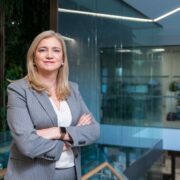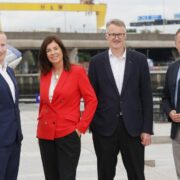Podcast Ep 170: CoolPlanet CEO Alan Keogh on the Irish-headquartered business’s global success in creating an operating system for carbon reduction.
Four years ago at the Powerscourt headquarters of CoolPlanet, its founder Norman Crowley spoke of his vision for helping businesses everywhere reduce their carbon footprint.
In recent weeks the Enniskerry decarbonisation company forged a deal with French company Lambert Dodard Chancereul (LDC), which has a turnover of over €5bn to assist in reducing electricity and gas consumption in LDC’s overall production process.
“If you have 50 factories and you require 500 projects to make the change, we would identify what they are and make sure they comply with the science-based targets and put them on a path towards 50% of reduction by 2030”
It proves actions speak louder than words. This is just one in a myriad of deals the Irish company has struck with organisations worldwide , including SSE Airtricity in Ireland, to reduce pressure on the grid from the energy consumption of businesses in areas such as data centres, pharmaceutical manufacturers, hotels, food producers, hospitals, quarries, and processing plants.
It is an all-industry affair. For example, almost a year ago CoolPlanet revealed it was investing €8m to develop pioneering technology to lower carbon emissions in the mining industry.
Making a CoolPlanet stamp on the world
In recent months the business launched a new software tool to help organisations reduce emissions and take climate action. CoolPlanet’s Net Zero Glidepath helps organisations visualise their path to Net Zero and understand what actions are required to get there.
The business expects 5m tonnes of carbon savings to be managed via the Glidepath in the next 12 months.
CoolPlanet CEO Alan Keogh sat down with ThinkBusiness recently to discuss the Enniskerry company’s ambitions.
“We’ve been in existence more than 12 years and we have spent most of that time going around the world and delivering big energy efficiency – or decarbonisation -projects in factories around the world and in different sectors from oil to meat, breweries, lots of different sectors.”
The Net Zero Glidepath technology is derived from an in-house technology used by the team to deliver for clients.
“We were on flights every week travelling the world and we found it difficult to pivot the business and roll out the software to the scale it should have been. We took the opportunity during the Covid-19 pandemic to pivot the business to be much more software-led. So we would lead with the software, gather data and then use that data to make much more informed decisions about where we would target the decarbonisation activities.”
Keogh said that at any one time CoolPlanet could be working with up to 200 projects where businesses are targeting savings of between 30% and 50%.
“So how do you do that, when you don’t have the expertise, you don’t have the data, you don’t have the manpower or you don’t have the capacity? But that’s where we come in. So we have all those things and we can give you the data and the analytics through the platform, CoolPlanet OS. And really, that’s how we help our customers is to scale decarbonisation in order for them to meet those targets that they’ve set for themselves.”
CoolPlanet’s Decarbonisation Management System CoolPlanetOS has been trusted by the world’s biggest brands for the last 15 years. Clients include Hilton Food Group, Viterra, Tirlan (formerly Glanbia), Bulmers, GE Healthcare, Louis Dreyfus Company, Dairy Farmers of America and more.
Keogh said that the initiative these and many businesses like them are aligning to is the pursuit of achieving science-based targets.
“The science based target initiative means that to stay on the path of 1.5, degrees warming, for the whole planet, which, you know, looks very optimistic at this point, you need to reduce your carbon emissions to align with that target. And typically, that means a 50% reduction by 2030. And net zero by 2050.
He said that at board level companies need to decide if they are going to pursue these science-based targets and they then need communicate that to the markets that they are on this path.
“That’s a massive commitment to say ‘we’re going to remove 50% of our carbon emissions from our operations and be at net zero by 2050’. We would come in at that point and go, ‘Okay, you’ve set your targets, great. So how are you going to deliver them?’ And we will do a baseline exercise, where we will go through all their sites and we will basically come up with a plan with them.”
And that’s where the CoolPlanet OS comes in. The key is visualisation and management and making use of renewable energy solutions from wind to wave and solar.
“If you have 50 factories and you require 500 projects to make the change, we would identify what they are and make sure they comply with the science-based targets and put them on a path towards 50% of reduction by 2030.”
Keogh explained that different businesses require different alternative energy solutions depending on their respective geographic location and industry. For example in Brazil they may use biomass whereas in the US it might be solar or heat pumps. “It could also be driven by energy or carbon prices in these different jurisdictions.
“Once we identify the projects that comply with science-based targets and plan a path to 50% carbon reduction by 2030 we can give them the tools and the technology to implement and where necessary we’ll put boots on the ground whether it’s in South America or Asia or North America.
“But the foundational platform that centralises all of those activities in one place is our CoolPlanet OS.”





